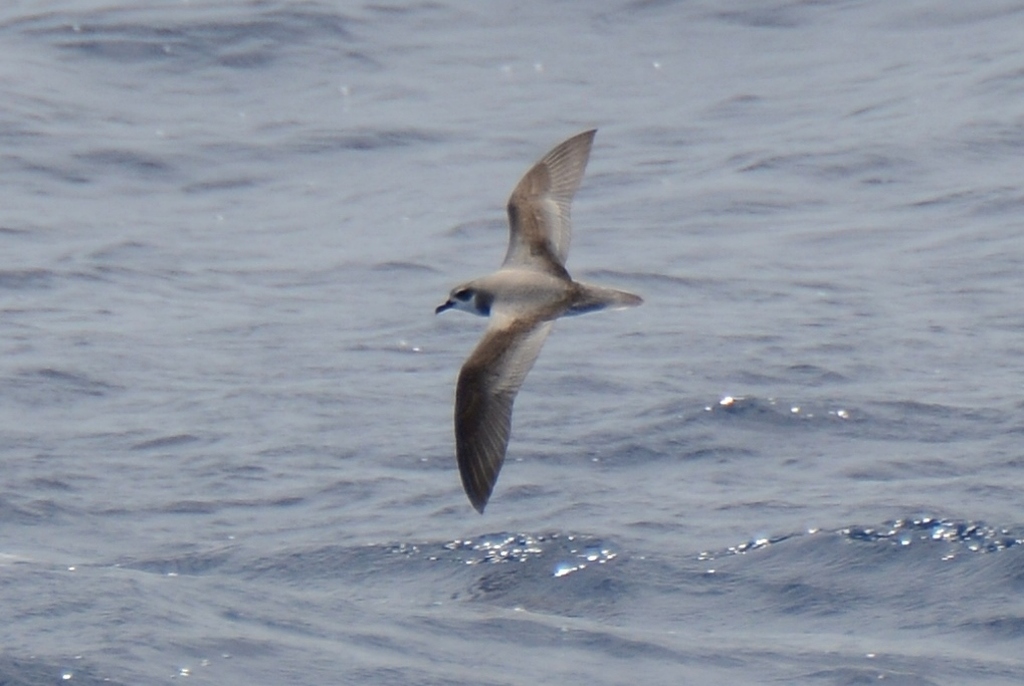Stormies and Wanderers
The human race has suddenly vanished from the streets and from the countryside and even from the ocean. All over the world, countries are in lock-down and ports are closed; all over the world, cruising yotties are being quarantined aboard their boats. And all over the world, while Homo sapiens hides from a deadly virus, wildlife is making a come-back. Or so they say.
Foxes and deer have apparently been seen ambling along empty high-streets, turtles are nesting on beaches where they haven’t been able to nest for years, and there are even photographs of bears wandering through people’s suburban gardens. However, there is one environment where the wildlife probably hasn’t noticed our absence, and that is the ocean. On the one hand, man has never been more than a vagrant on the ocean – so the birds and the dolphins won’t notice a lessening of the few – and, at the same time, the fishing boats and the factory ships have not gone to harbour – they are still merrily pillaging away – and the container ships are still ferrying our food around the world.
Fishing is having a devastating effect on the oceans, and the volume of carbon gas pumped out by our cargo ships is greater even than that produced by the aviation industry. Cruise liners are even worse. But a sailing vessel crossing the ocean has very little impact on what goes on out there; and indeed, what little impact she does have might even be wholesome. If you leave a boat drifting on the ocean it very soon becomes a focal point for sealife, and if no humans are aboard, the deck and the rigging are swiftly claimed by the birds. One might assume that this is because the hull is attractive to crustacea, and thus to small fish, and thus to bigger fish… and so on down the line; a food-web is built. However, a boat which is moving is also attractive to seabirds. It would seem that even the ocean wanderers long for a fixed feature in the ever-changing emptiness!
Because of this tendency on the part of the birds, at any one time whilst on passage we are probably seeing more than the average population density for the area that we are traversing. There are times when this is a depressing thought; there are times and places where the ocean appears to be a desert, supporting almost no birds whatsoever. But now and then we enjoy a passage where the birdlife is abundant – and one such was our three-day journey from Valdivia to Juan Fernandez.
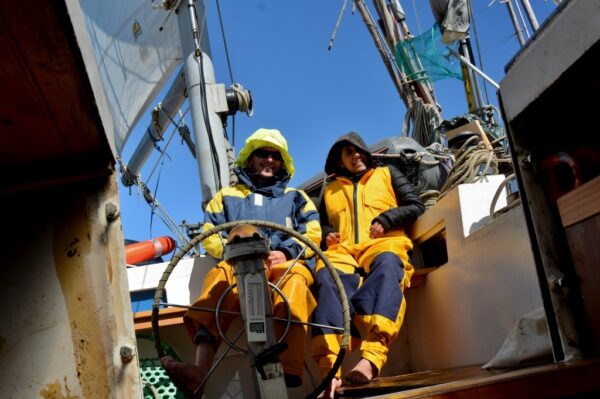
Close to the coast, as we were setting out from Valdivia, we encountered a multitude of birds, greater in number than I can recall seeing anywhere else in the world. There were scores of giant petrels, large rafts of shearwaters, numerous albatross, clouds of prions, and flocks of Wilson’s storm petrels. Sharing the air with these ocean birds, while the coast was still close at hand, there were also lots of kelp gulls and cormorants and a few red-legged shag.
This abundance filled us with joy, for it hinted at ideas of an ocean unharmed by man’s excesses. However, I suspect that this was actually just a case of what ecologists call ‘shifting base-line syndrome’. When we first started to sail the oceans, Nick and I became accustomed to the fact that there were always one or two shearwaters and stormy petrels in sight, and so we took that to be ‘the norm’. That became our base-line. Now, when there are few birds or none at all, we note this with dismay; but when there are more than a dozen, we start to think that all is well with the world!
The throng of birds in the entrance to the Rio Valdivia far exceeded our base-line, so that it seemed like a reversion to the natural state of the world. In reality, however, what seemed to us to be a multitude was probably no more than a hint at the abundance which surely filled the air a couple of hundred years ago.
A strong current runs up the coast of Chile, carrying plankton from the Southern Ocean. Meanwhile, the Rio Valdivia also pours forth a cornucopia of nutrients. This might explain why there were so many birds flocking on the sea outside the entrance to the river. As the coast faded, the land-lubbers amongst the multitude fell astern, but the ocean-dwellers continued to flock around us. We were particularly pleased to see the ‘stormies’. Pattering about with their feet on the surface of the sea, or zipping to and fro on the blue slopes like bats chasing after flies, these tiny fellows seem far too fragile to cope with wind and waves – and yet mountainous seas are their ‘home sweet home’.

Wilson’s storm petrels occur throughout most of the Pacific, the Atlantic, and the Indian oceans, inhabiting the whole area from the Southern Ocean all the way up, through the tropics, across the equator, and up to the top of the northern gyres. At one time the species was reckoned to be the most abundant in the whole world, and thirty years ago we could expect to see ‘Wilsons’ flitting around the boat whenever the wind was up. Now, however, storm petrels of any sort are a fairly rare sight. The industrial plundering of the ocean has evidently harmed their food supply. Plainly, these tiny little fellows are not eating anything that man might want to catch, but perhaps they rely on the ocean-wandering larval stage of some sort of crustacean; or perhaps they eat the eggs and sprat of some kind of fish which we are driving towards extinction.
The web of life is complicated.
We were also excited to see the little flocks of prions, their synchronised flight and togetherness mirroring that of the shoals of fish swimming somewhere below us all. Prions, too, are nowadays quite rare, and they are also very pretty. Since I didn’t get a photo I can’t be sure of the species, but they were very pale grey, and the after part of their wings was almost white. I think this makes them slender-billed prions.
As we moved further from the coast we saw no more prions and we saw far fewer stormies, but we did see a lot of shearing, swooping petrels. Predominantly brown but with white bellies and dark eye-patches, these birds flung themselves about, sometimes almost dipping the tip of their lower wing in the waves as they sheared past. Whereas the albatrosses were swinging across the ocean, riding the invisible elevators above each wave, these chaps flicked to and fro, twisting – now this way, now that – in knife-edge flight. They were like spitfires beating up an airfield. Or like shearwaters… However, close inspection of photos snapped while the boat romped along showed that few actually were shearwaters; the majority were gadfly petrels.
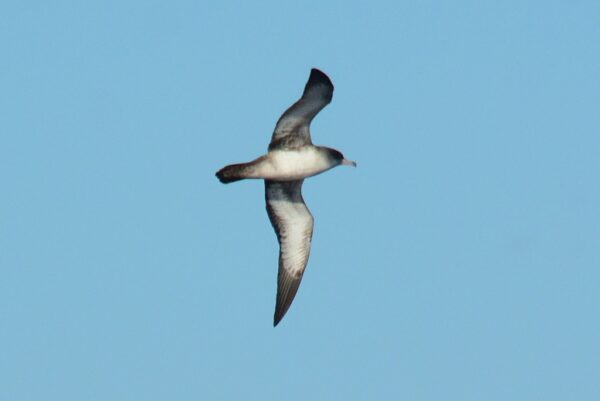
A perusal of Harris, the seabird bible, revealed that there were four potential candidates amongst the gadflies:
Kermadec petrel (Pterodroma neglecta)
Juan Fernandez variant of white-necked petrel (P. externa)
Stejnegar’s petrel (P. longirostris)
Juan Fernandez variant of Cook’s petrel (P. cooki defilipiana).
This last could be ruled out because although it nests on the islands in the winter, during the summer it goes elsewhere.
The majority of the birds that we saw had the distinctive bi-coloured wings of Stejneger’s bird: They had a grey back, and the leading edge to the wing was also grey, but the flight feathers were brown. Such a bird, fleetingly glimpsed as it flicks by, appears marked with a brown M.
Others, with the same brown M on an all-brown back, were evidently Juan Fernandez variants of the so-called white-necked petrel. None of them had the white collar shown in Harris, but most had a white rump which he does not show for the Juan Fernandez bird.
Harris was writing and painting some 35 years ago. Since this time, improved photography has enabled people to acquire sharper images of the birds, and DNA technology has enabled scientists to explore the relationships between the various look-alikes; so it may be that my nomenclature is out of date. It may be that the Juan Fernandez variant is, in fact, an entirely separate species from its white-necked kin. Regardless, the facts at our disposal gave us the opportunity to attach handles to each different bird type and thereby allot them identities. In reality such things are no more than hand-rails in the darkness – “This is where you belong on my mental structure, bird” – for the human psyche does so love to create order from chaos and to find function and friends amongst the flora and fauna with whom we share the world.
I had expected to see a few mollymawks on this trip. Black-browed mollies are still fairly abundant and are one of the commonest birds in the Chilean Channels and around Cape Horn. As it was, however, we saw very few mollies after we’d left the coast, but we dozens of wandering albatross. Or perhaps they were royal albatross…
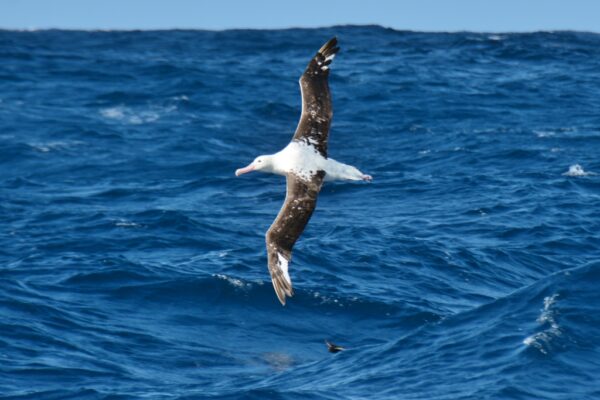
During our first day at sea these enormous, majestic birds were constantly around us. Sometimes they glided the waves alone, but more often they waltzed past as a pair, and sometimes there were six in sight at the same moment. Even so – and even the with Harris in my hand – I couldn’t decide which species they were: wanderers or royalty. In fact, even with a handful of reasonably good photos and the bird book, I still can’t decide, because they have some of the given characteristics of each species. Perhaps it doesn’t matter…
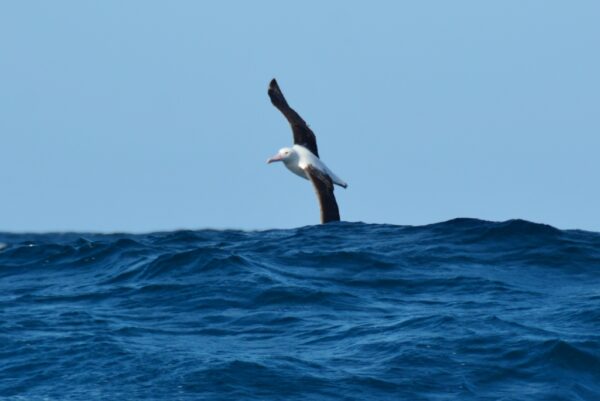
Whenever a mollymawk swung into sight, I realised anew that although the wanderers/royals are impressively big, the mollies are the more graceful of the two albatross clans.
The wanderer has a massive, barrel-shaped torso, and his snow-white feathers hide massive chest and shoulder muscles. These muscles have to hold erect, or rigid, high-aspect wings which can be 14ft from one tip to the other. Imagine the strength needed for that! Truly, a wanderer is like a little glider-plane sliding about in the sky.
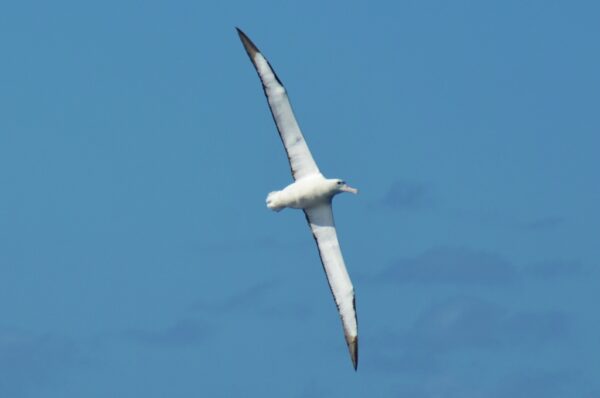
But magnificent though they undoubtedly are, these huge birds actually do quite a bit of flapping (principally when they wish to change direction swiftly); and their head and beak are as over-sized and ungainly as those of a giant petrel. The mollymawk, by contrast, is smaller – his wingspan is a mere 7-8ft – but his proportions are absolutely perfect. The head, the beak, and the torso all seem perfectly balanced. And as he swings over the waves with lazy ease, this bird is the embodiment of grace. Given sufficient wind, there is no flapping; a mere tweak of the wing-tip feathers sends him suddenly soaring aloft.
This way he wheels, and then that. He is systematically quartering the sea and hunting for his fodder – or so one must assume! – yet he appears to be there simply for the joy of flight.
“O’ I have slipped the surly bonds of earth and danced the sky on laughter silvered wings.”
I can never see a mollymawk swinging and swooping over the waves without thinking of John Magee’s poem, and I can never watch him without my spirits being lifted.
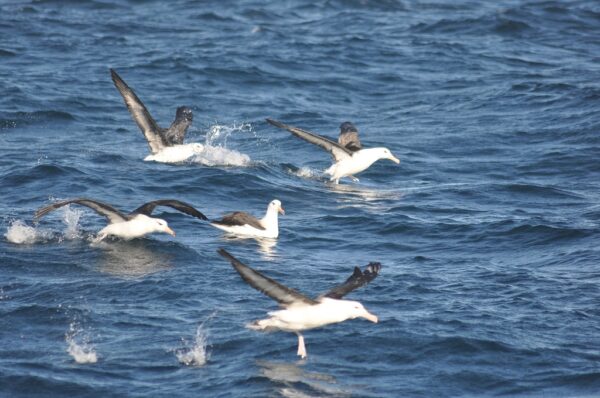
What do they eat, these ocean tramps? Fish? Squid? Crustacea…? Anything that comes along, I imagine – and thus the young of the world’s northern species of albatross are frequently fed items of plastic.
“How can these birds be so very stupid?” I hear someone ask – but the fact is that intelligence does not enter into this scheme. We are dealing, here, with base instinct. There is nothing – absolutely nothing – in the natural marine world which an albatross might not safely feed to its chicks. A piece of plastic is detected as ‘not vegetable’ (which would be harmless but useless to the bird), and therefore it must be animal = food. If the item has absorbed some scent of natural or petroleum oils, then it is even more likely to stimulate the bird to recognise it as a tasty morsel.
For birds hunting in the southern oceans, an even bigger threat to survival comes from fishing boats. A long-liner recovering its 50 mile trace of baited hooks frequently hauls in dead albatrosses which pounced on the glittering offering. The industry is attempting to address this problem, but with results which are less than satisfactory. Individuals such as you or I can do our bit for the ocean birds – and, indeed, for the very balance of life on this little blue planet – by the very simple expedient of not buying fish.
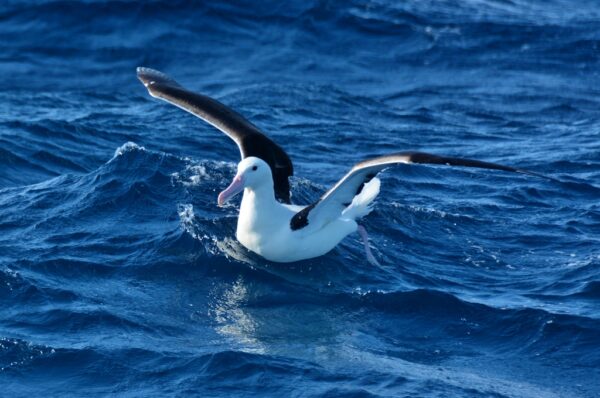
People are suggesting that during this viral pandemic we are catching a glimpse of what the world will be like after we are gone. This is what it will be like after we’ve trashed the environment so badly that it no longer supports human life, they proclaim; Mother Nature will spring back and all will be hunky-dory. But the truth is that once the planet is in such a state that it won’t support Homo sapiens, it won’t support any of the higher forms of life.
If we want Nature to really make a come-back, we need to stop beating her up. On the far side of this pandemic we must build a different sort of civilisation.

